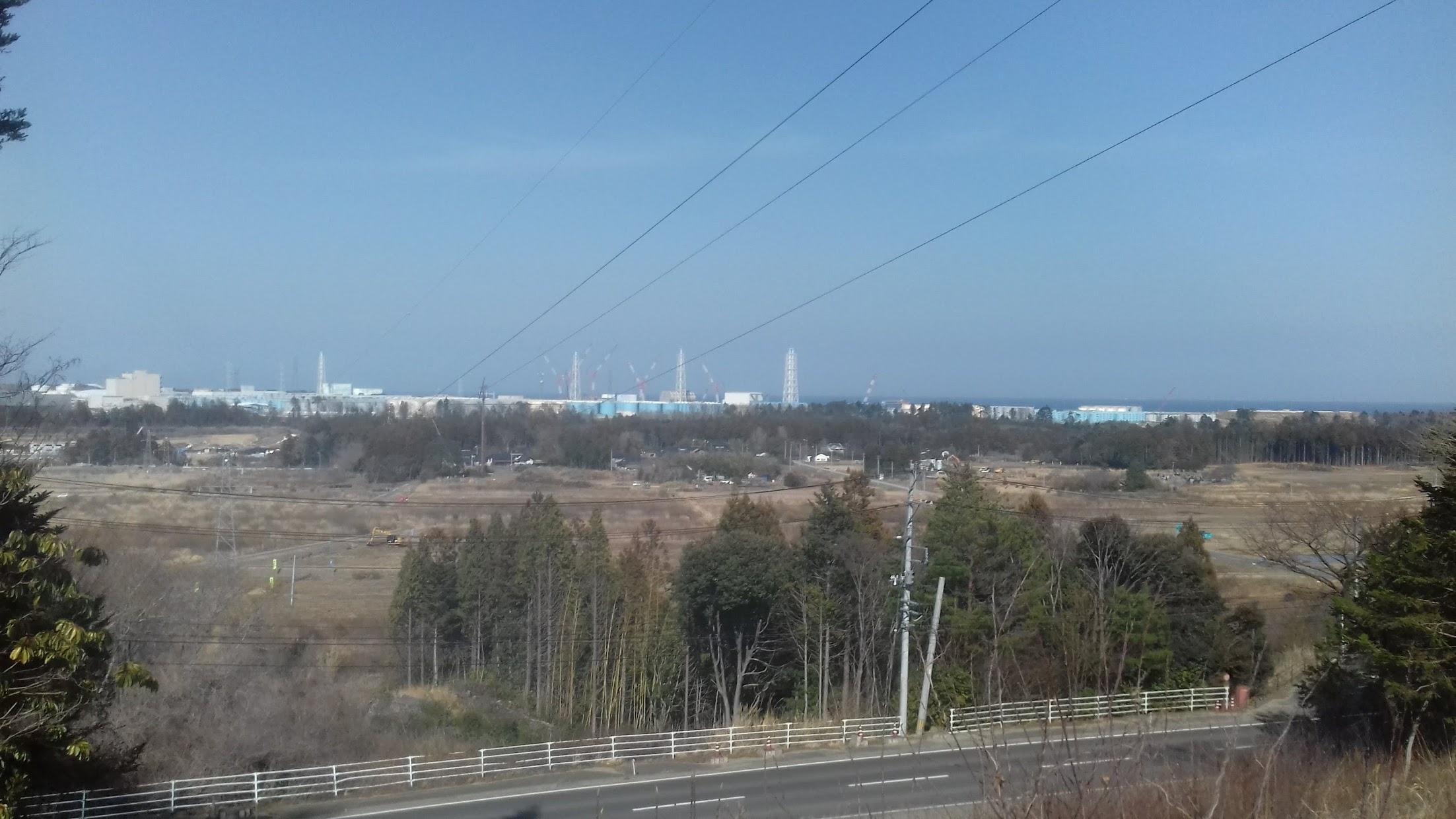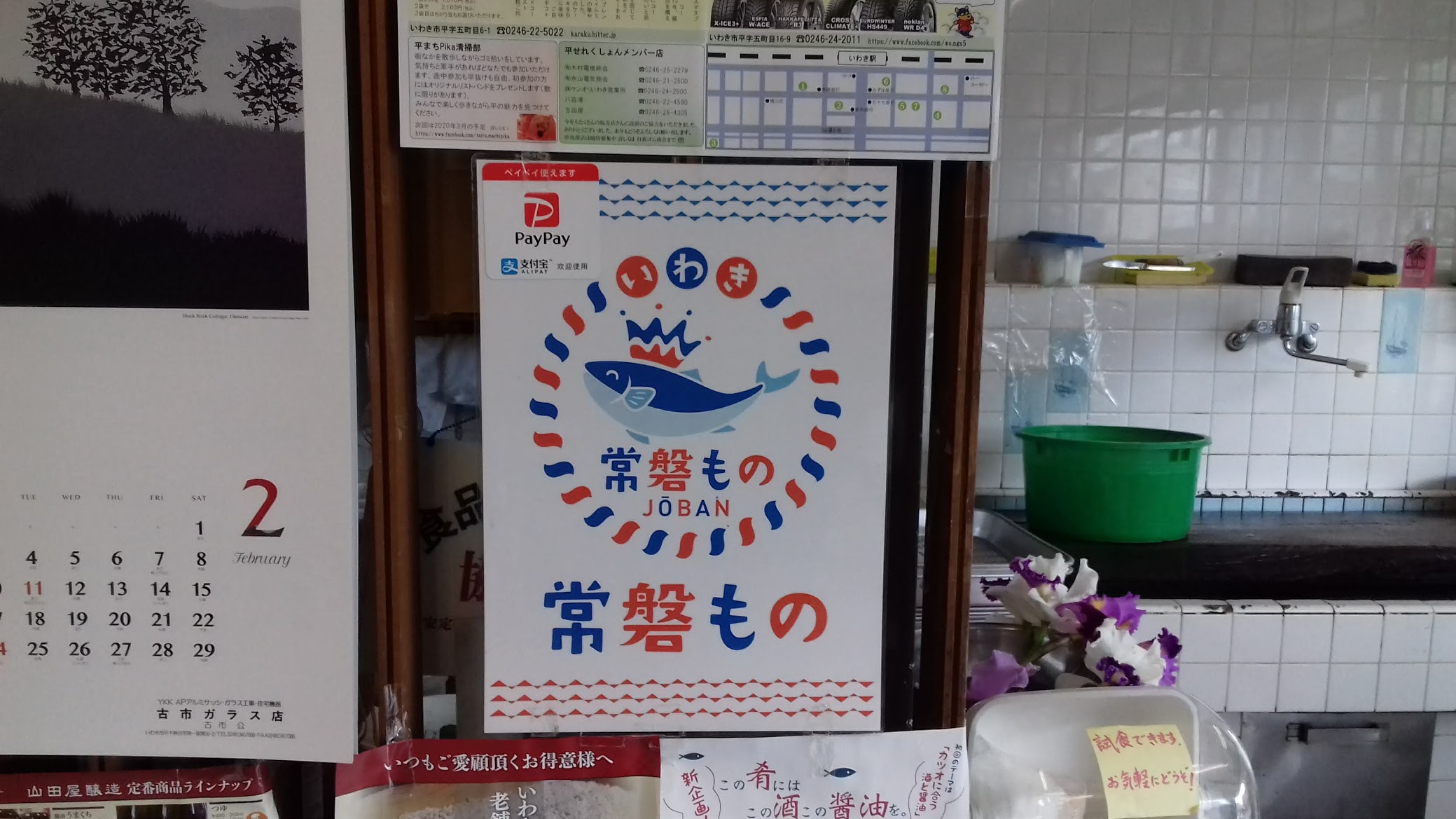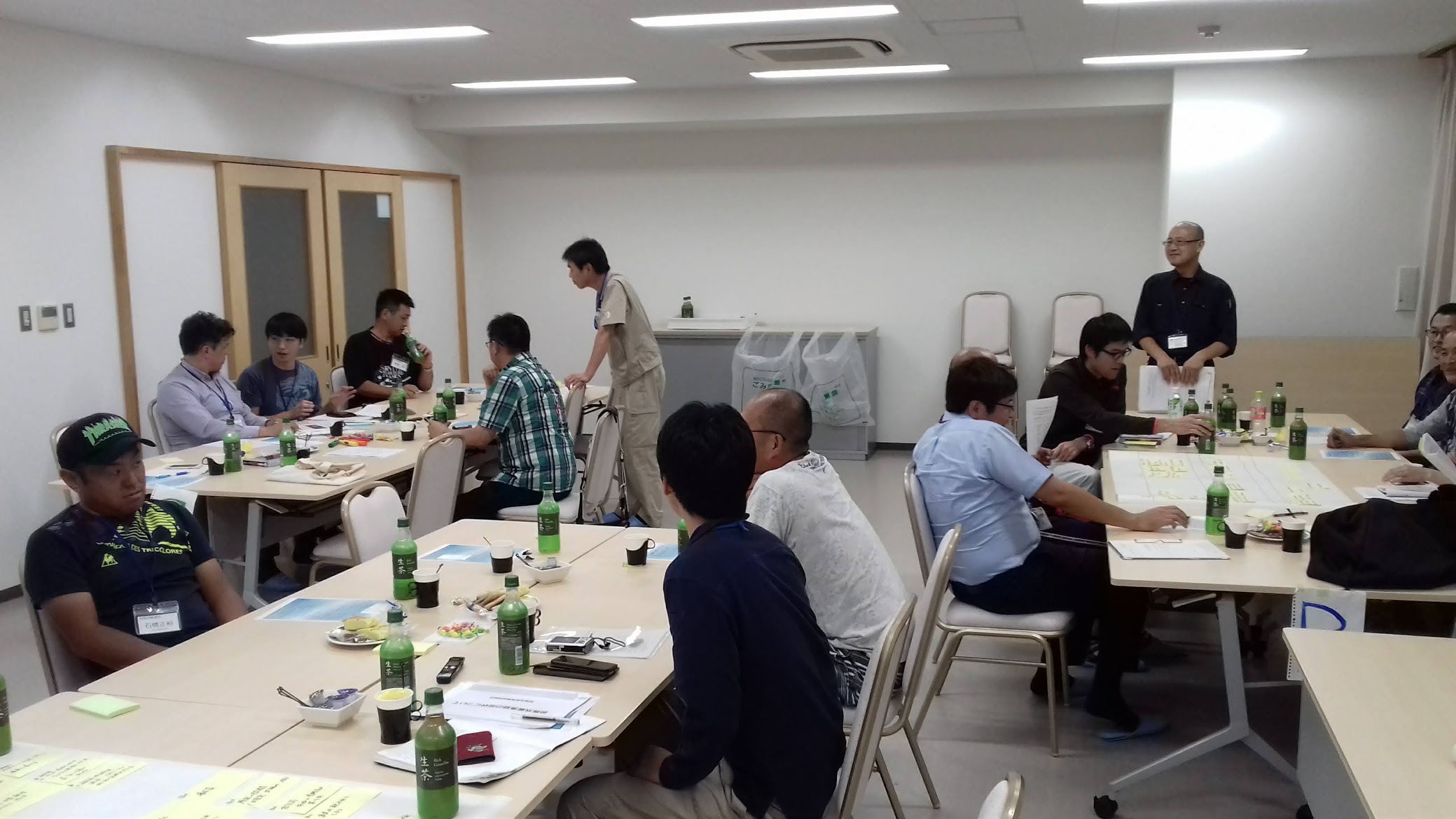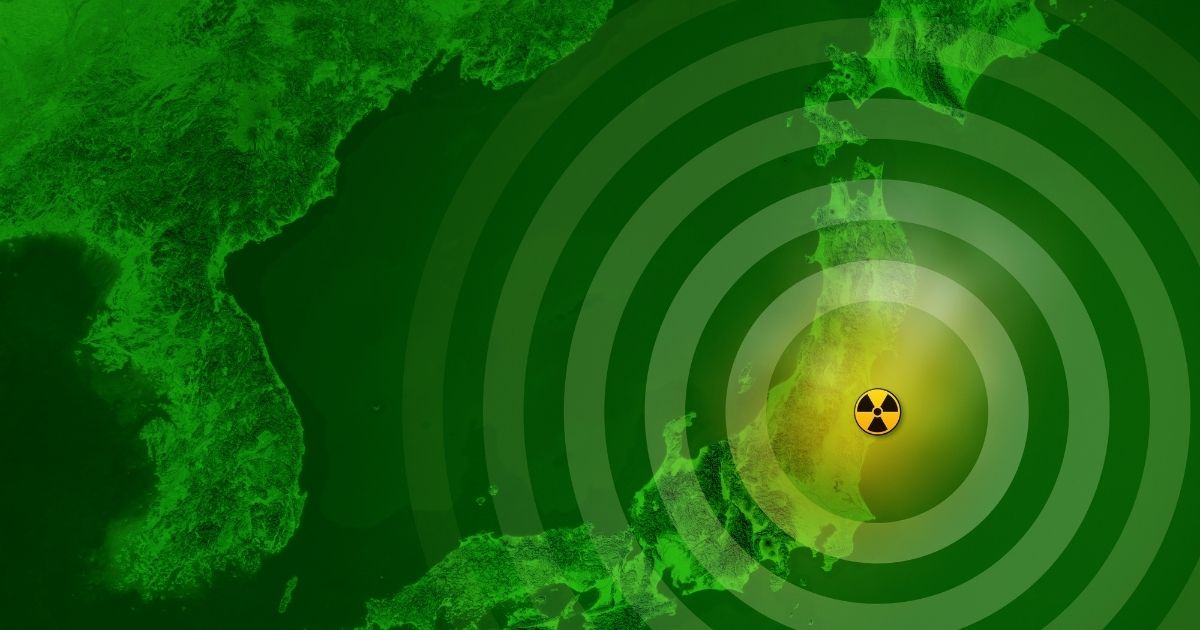On Tuesday 13 April 2021, reports emerged from Japan’s Kyodo News agency on the Japanese government’s decision to release treated radioactive water from the Fukushima Daiichi nuclear power plant into the Pacific Ocean, having determined it poses no safety concerns despite opposition from local fishers and neighboring countries.
Dr Leslie Mabon, Scottish Association for Marine Science (SAMS), provides a short summary of the current situation around the controversy. He synthesizes evidence from his own research into Fukushima fisheries, which has been ongoing since 2014, and also draw in material from leading independent international academic experts on the topic.
 Fukushima Dai’ichi (note water tanks) from Okuma Town, March 2019
Fukushima Dai’ichi (note water tanks) from Okuma Town, March 2019
What is happening at the Fukushima Dai’ichi nuclear power plant?
Since the 2011 nuclear accident, when the earthquake and tsunami knocked out cooling systems at the plant and triggered three hydrogen explosions plus meltdowns at Fukushima Dai’ichi, it has been necessary to inject water into the damaged reactors to keep them cool. Whilst this water can to an extent be treated to remove some of the more harmful substances, not everything can be removed from the water with the techniques available. Therefore, water that has been used to cool the damaged reactors, along with recovered groundwater, has been stored on-site at the Fukushima Dai’ichi plant in storage tanks. However, space is finite, and plant operator Tokyo Electric Power Company claim they will run out of space by 2022.
On the basis of consultation with an expert committee and despite appeals from fishers, consensus on the most appropriate course of action is to release some of this water into the north-west Pacific Ocean. In April 2021, the Japanese Government reached a final decision to release the treated water into the sea.
 Poster showing shop sells locally-landed produce, Iwaki, January 2020
Poster showing shop sells locally-landed produce, Iwaki, January 2020
When will the water be released?
Details on the specifics are so far limited. Japan’s Kyodo News agency reports that the Japanese Government will start discussions in mid-April to develop a concrete plan for discharging the water. This is a process that is likely to take some time, probably several months, to confirm. The actual water releases are not likely to happen for one or two years.
 Workshop with fishers, Soma-Futaba Fisheries Cooperative, September 2019
Workshop with fishers, Soma-Futaba Fisheries Cooperative, September 2019
What is in the water that is being released, and will it be harmful to people?
The main contaminant contained within the water is tritium. This is very hard to remove through treatment because it is a radioactive form of hydrogen that is part of water molecules themselves. Woods Hole Oceanographic Institution researcher Ken Buesseler, in a recent Science article, also suggests the tanks contain contaminants such as ruthenium-106, cobalt-60, and strontium-90. Whilst these are in much lower quantities than tritium, Buesseler points out that these contaminants behave differently in the ocean and may be more readily incorporated into sediments or marine biota.
Nonetheless, international scientific consensus is that the material contained in the water to be released, if protocols are followed correctly, is very unlikely to pose any risk of harm to people, fish or the wider marine environment. For independent expert scientific evidence to support this point, see Ken Buesseler’s Science paper and Twitter account, and also this helpful Twitter thread by Jay Cullen of the University of Victoria.
You might also be interested in the talk series and open-access scientific posters, which are all available freely online from the ‘Fukushima Dai-ichi and the Ocean: 10 years of study and insight‘ virtual event held online in March 2021. The talks and posters cover everything from marine biology and chemistry through to policy, governance and social science.
If the water released is unlikely to harm people’s physical health, then why is it so controversial?
Reputational damage to Fukushima fisheries is the main cause for concern. Since 2011, fisheries cooperatives in Fukushima Prefecture have put significant effort into revitalizing local fisheries. A critical part of this has been extensive risk communication efforts to rebuild public trust in produce landed in Fukushima ports, through extensive monitoring campaigns and information provision to reassure consumers that Fukushima fish are free from contamination and, indeed, delicious to eat.
For example, fish landed at Fukushima ports have just moved from the ‘trial fisheries’ to the ‘expansion fisheries’ stage, and every catch is screened for radioactive cesium. Fish are screened for radioactive cesium to a standard of 50 Becquerels per kilogram, compared to a standard of over 1250 Becquerels per kilogram for fish in the European Union (a Becquerel is a standard unit measuring radioactivity). Screening and monitoring results are available online for consumers to check, and have been accompanied by an extensive public communication campaign.
The Fukushima Prefecture Federation of Fisheries Cooperative Associations has set ambitious targets for the revitalization of Fukushima fisheries from now into the future, including a goal to return trawling activity in the Soma area in the north of the region to over 60% of pre-disaster capacity by 2024. In spring 2021, the cooperatives also decided to move from ‘trial’ fisheries to ‘expansion’ operations. However, the fisheries cooperatives’ worry is that if water perceived as being contaminated is released into the sea, then consumer trust in the quality and safety of fish will collapse and their risk communication efforts will have to start again from zero.
But surely all we need to do is tell consumers that the water being released is not harmful, and that fish remain safe to eat?
There is an extensive body of evidence from the social sciences which shows that providing more and more scientific information alone will not convince people of the safety of a particular course of action. Different people have different views on what constitutes an acceptable level of risk, which are influenced by a wide range of factors. For instance: do we trust the people taking actions and assessing the risks? Who stands to benefit from the actions being taken? Have we been fairly consulted over the course of action? Specific to radioactivity, previous research by Deborah Oughton from the Norwegian University of Life Sciences indicates that following a nuclear accident, remediation actions that involve the perceived contamination of environments viewed as unspoiled are likely to be viewed negatively. Releasing water containing contaminants into the north-west Pacific Ocean may well fall into this category. Drottz-Sjoberg and Persson, in a 1993 text, perhaps sum it up best: ‘perception of risks is complex and it is a mistake to dismiss public anxiety towards radiation risks as being “irrational” or “wrong”.’
Can’t we just compensate fishers for loss of income?
In theory, yes. Fishers have been receiving compensation since 2011. But as the research I have undertaken with Midori Kawabe of Tokyo University of Marine Science and Technology has shown, fishing is not just an economic activity. It is a source of pride and identity for fishers and coastal communities, and has given fishers a renewed sense of purpose post disaster. Indeed, in our last rounds of fieldwork in autumn 2019 and spring 2020, fishers were deeply concerned about the possibility of water releases.
This, perhaps more than anything else, is what makes the issue of water at Fukushima Dai’ichi so difficult to resolve. How the underpinning science is interpreted, and how the most appropriate course of action is interpreted, is deeply connected to people’s own value positions and sense of who they are. No matter how much we may wish to be guided by ‘the science’, these decisions involve people and hence are inevitably social.
For more of the social context on the Fukushima coast, check out this virtual field trip I made recently.
Further reading
If you’re interested in reading more about the research on Fukushima fisheries I’ve done with Tokyo University of Marine Science and Technology, you can find open access versions of the papers here. If you’re interested in knowing more about our newest findings, email me at This email address is being protected from spambots. You need JavaScript enabled to view it..
This explainer and the research on which it is based are currently funded by a Scottish Government-Royal Society of Edinburgh Scotland-Asia Partnerships in Higher Education grant.
Note: this post was originally published in October 2020, as plans to release treated water progressed towards approval. The explainer was updated in April 2021 to reflect the confirmation of the Japanese Government’s decision to release the treated water. I will continue to add more information as and when it becomes available.
By Dr Leslie Mabon, Scottish Association for Marine Science (SAMS)





